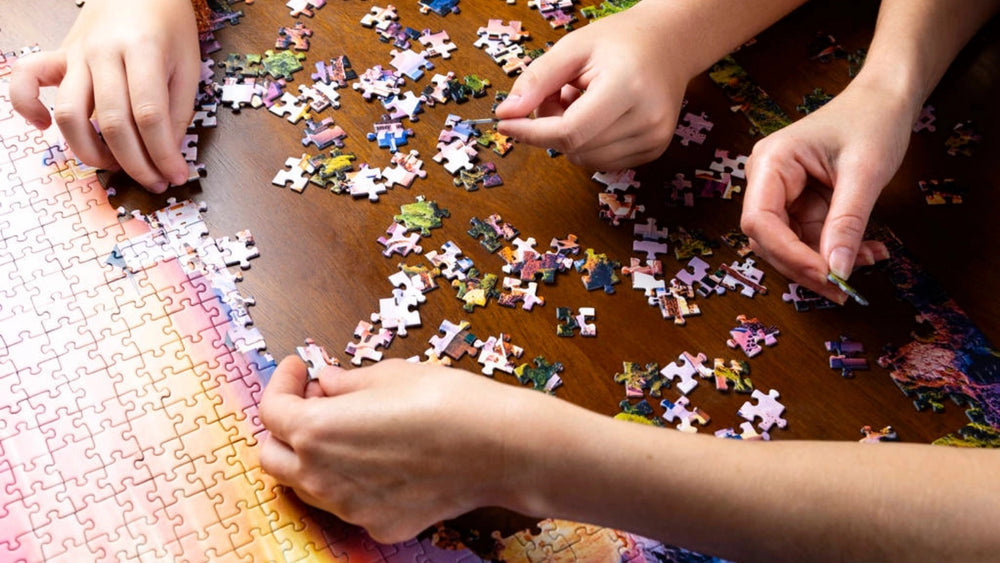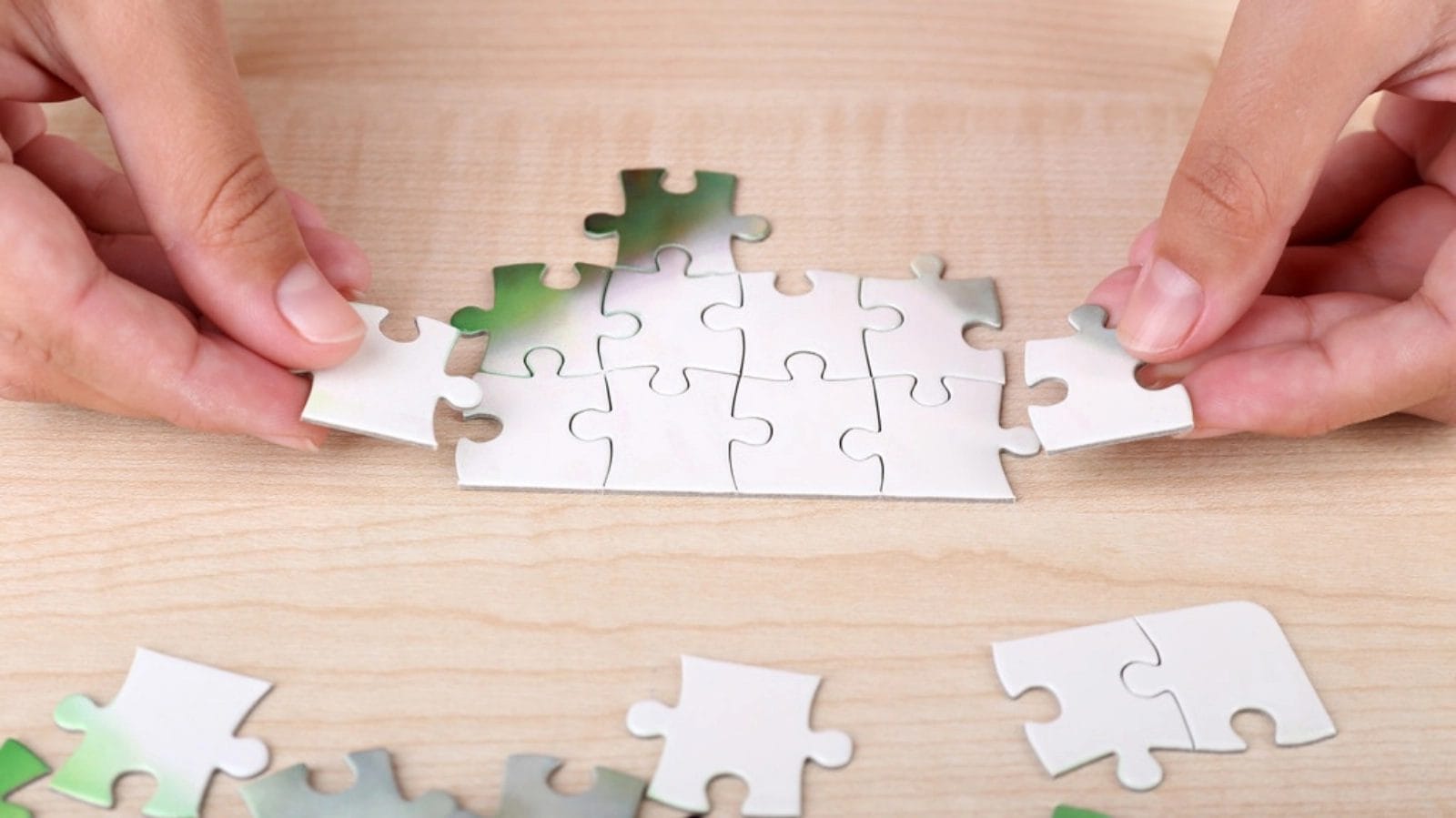
Some people can complete jigsaw puzzles with remarkable speed and precision. But others struggle for hours with little progress. The difference isn't natural talent—it's strategy. So, what is the trick to jigsaw puzzles?
No matter the puzzle size, success depends on your approach, workspace setup, and techniques used. Let's explore the systematic tips and tricks that can transform your puzzle-solving experience.
Key Takeaways
- Sort the pieces by color and pattern. Then, build the frame with edge pieces to create a solid foundation.
- Work in small, manageable sections rather than tackling the whole puzzle at once.
- Use a puzzle mat or dedicated workspace to keep pieces organized and prevent losing them.
- Study the reference image on the box frequently to understand color patterns and piece placement.
- Sort similar pieces into separate containers or designated areas.

Ready to tackle a jigsaw puzzle but not sure where to start? Here are 7 practical tips for mastering the art of puzzling.
Tip 1: Choose a Work Area
Before starting any jigsaw puzzle, it's essential to select an appropriate workspace. Set up your puzzle board or dedicated puzzle table in a well-lit area away from high-traffic zones.
Choose a sturdy, spacious, flat surface large enough to spread out pieces. A puzzle mat prevents shifting while working and helps maintain organization. Also, ensure proper lighting to reduce eye strain.
Tip 2: Sort and Organize Pieces
With your workspace properly set up, the next step is systematic piece organization. Start by sorting pieces into distinct categories: edges, colors, patterns, and internal sections.
Group similar pieces in separate containers or designated areas of your workspace.
Tip 3: Start with the Edges
Once you've sorted your pieces, assembling the edges forms the critical foundation of your jigsaw puzzle strategy. Begin by identifying all edge pieces, which have one flat side.
As you connect border pieces, you'll establish a clear frame for your puzzle. This structured approach helps you visualize the overall image while building outward from the edge of the puzzle.
Tip 4: Build Sections
Your next step is to break down the puzzle into smaller, manageable sections. Sort the pieces by color, pattern, or distinct features to create sections you can focus on individually.
As you build up your puzzle, connect these sections strategically. You'll find it easier to assemble puzzles when you tackle them in organized, bite-sized segments.
Tip 5: Use Reference Images
The cover image of the puzzle box serves as your essential roadmap throughout the assembly process. When solving a jigsaw, position the reference image where you can easily see it.
Study color patterns, distinct objects, and shifts between sections. You'll assemble pieces more efficiently by matching them to specific areas on the image. So you can solve complex sections systematically.
Tip 6: Stay Organized
Maintaining an organized workspace is essential for efficient puzzle-solving. To categorize puzzle pieces by color and pattern, use sorting trays. Keep your sorted pieces in designated containers to prevent mixing.
When you feel overwhelmed, step away briefly to refresh your perspective. Then, with renewed focus, tackle sections systematically using your organized arrangement.
Tip 7: Frame the Completed Puzzle
Once you've pieced together every part of the puzzle, consider displaying it as art.
To do this, carefully slide a large piece of cardboard underneath your puzzle to stabilize it. Then, apply puzzle glue to keep the pieces in place. Once dry, you can mount the puzzle in a frame that complements its design and colors.
This not only preserves your hard work but also adds a unique piece of decor to your space.
Advanced Puzzle Tips for Jigsaw Puzzles
Having mastered the essential methods, you’re ready to learn some expert tips. They can make complex puzzles more manageable.
Focus on Patterns and Colors
Successfully identifying patterns and colors represents a critical advanced technique. You'll want to sort pieces by color and group similar patterns together.
Look for areas of the puzzle with dominant color schemes or distinct gradients. Pay special attention to subtle variations in shading. Because these nuances often show where specific pieces connect within challenging gradient puzzles.
Work in Small Sections
Break down a complex jigsaw puzzle into smaller, manageable sections. This will transform an overwhelming challenge into a series of achievable goals. When you focus your time on one section of the puzzle, you'll find piece puzzles easier to complete.
Start by identifying distinct areas where puzzle pieces share common characteristics. Then, work methodically to connect these completed sections into the larger framework.
Take Breaks and Stay Persistent
When you hit a mental block, step away from the puzzle briefly. This allows your brain to process information subconconsciously. You'll often return with fresh insights to work inside as you build.
The hit of dopamine when you finish the puzzle makes the challenge worthwhile, so don't give up.
Tips for Improving Solving Jigsaw Puzzles Quickly
If you want to enhance your jigsaw puzzle skills, here are some practical tips to help you solve them more efficiently.
Practice regularly
Regular practice is the cornerstone of mastering jigsaw puzzles. Even 30 minutes daily can yield significant improvements in speed and accuracy.
By gradually increasing piece counts and complexity, you'll find yourself putting different puzzles together more quickly. Track your progress in a puzzle logbook. Connect with puzzle communities to learn valuable tips from experienced puzzlers.
Challenge with Gradually More Complex Puzzles
Advancing to more complex puzzles can sharpen your problem-solving abilities. Tackle puzzles with different categories of difficulty—more pieces, challenging patterns, or irregular shapes.
As you work with more complex designs, you'll learn ways to assemble detailed parts. Don't rush; it's natural to spend a lot of time on each puzzle like this.
Conclusion
Master jigsaw puzzles by implementing a strategic system of organization and methodical execution. Start with proper workspace setup, sort pieces systematically, and construct from edges inward.
Through consistent practice and gradual progression to more complex puzzles, you'll develop pattern recognition skills and spatial awareness.
Combining these elements with patience and strategic breaks will substantially improve your puzzle-solving efficiency and success rate.
FAQs
What Is the Secret to Jigsaw Puzzles?
You'll succeed at jigsaw puzzles by:
- Create a clean workspace.
- Sort pieces by color and edges first.
- Break the puzzle into sections.
- Use a methodical approach for placing pieces and recognizing patterns.
Is There a Pattern to Jigsaw Puzzles?
You'll find patterns through piece shapes, color gradients, and image sections. You can identify these by sorting edge pieces first, grouping similar colors, and working systematically from borders inward.
How to Beat Jigsaw Puzzles?
Beat jigsaw puzzles by starting with edges, sorting pieces by color, and working in zones. Create a clutter-free space and follow the paper grain. Don't forget to use lighting strategically for better visualization.